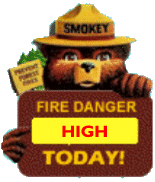|
|

PA. DCNR
DISTRICT 17
TODAY
20 January, 2007

|
Low |
Fuels do not ignite readily from small
firebrands although a more intense heat source, such as
lightning, may start fires in duff or punky wood. Fires
in open cured grasslands may bum freely a few hours
after rain, but woods fires spread slowly by creeping or
smoldering, and burn in irregular fingers. There is
little danger of spotting. |
|
Moderate
|
Fires can start from most accidental
causes, but with the exception of lightning fires in
some areas, the number of starts is generally low. Fires
in open cured grasslands will burn briskly and spread
rapidly on windy days. Timber fires spread slowly to
moderately fast. The average fire is of moderate
intensity, although heavy concentrations of fuel,
especially draped fuel, may burn hot. Short-distance
spotting may occur, but is not persistent. Fires are not
likely to become serious and control is relatively easy. |
|
High
|
All fine dead fuels ignite readily and
fires start easily from most causes. Unattended brush
and campfires are likely to escape. Fires spread rapidly
and short-distance spotting is common. High-intensity
burning may develop on slopes or in concentrations of
fine fuels. Fires may become serious and their control
difficult unless they are attacked successfully while
small. |
|
Very
High
|
Fires start easily from all causes and,
immediately after ignition, spread rapidly and increase
quickly in intensity. Spot fires are a constant danger.
Fires burning in light fuels may quickly develop high
intensity characteristics such as long-distance spotting
and fire whirlwinds when they burn into heavier fuels. |
|
Extreme
|
Fires start quickly,
spread furiously, and burn intensely. All fires are
potentially serious. Development into high intensity
burning will usually be faster and occur from smaller
fires than in the very high fire danger class. Direct
attack is rarely possible and may be dangerous except
immediately after ignition. Fires that develop headway
in heavy slash or in conifer stands may be unmanageable
while the extreme burning condition lasts. Under these
conditions the only effective and safe control action is
on the flanks until the weather changes or the fuel
supply lessens. |
|
FUEL/MOISTURE HOUR RATINGS
Dead
fuel moisture responds solely to ambient environmental
conditions and is critical in determining fire
potential. Dead fuel moistures are classed by timelag. A
fuel's timelag is proportional to its diameter and is
loosely defined as the time it takes a fuel particle to
reach 2/3's of its way to equilibrium with its local
environment. Dead fuels in NFDRS fall into four classes:
- 1-hour, less than
1/4" diameter.
Fine flashy fuels that
respond quickly to weather changes. Computed from
observation time temperature, humidity, and
cloudiness.
- 10-hour, 1/4 to 1"
diameter.
Computed from
observation time temperature, humidity, and
cloudiness. Or can be an observed value, from a
standard set of "10-Hr Fuel Sticks" that are weighed
as part of the fire weather observation.
- 100-hour, 1 to 3"
diameter.
Computed from 24-hour
average boundary condition composed of day length,
hours of rain, and daily temperature/humidity ranges.
- 1000-hour, 3 to 8 "
diameter.
Computed from a 7-day
average boundary condition composed of day length,
hours of rain, and daily temperature/humidity ranges.
|
|
THE HAINES INDEX
The Lower Atmosphere Stability
Index, or Haines Index, was developed for fire weather
use. It is used to indicate the potential for wildfire
growth by measuring the stability and dryness of the
air over a fire. It is calculated by combining the
stability and moisture content of the lower atmosphere
into a number that correlates well with large fire
growth. The stability term is determined by the
temperature difference between two atmospheric layers;
the moisture term is determined by the temperature and
dew point difference. This index has been shown to be
correlated with large fire growth on initiating and
existing fires where surface winds do not dominate
fire behavior.
The Haines Index is computed from
the morning (12Z) soundings from RAOB stations across
North America.
The Haines Index can range between
2 and 6. The drier and more unstable the lower
atmosphere is, the higher the index.
- 2 : Very Low Potential -- (Moist Stable Lower
Atmosphere)
- 3 : Very Low Potential
- 4 : Low Potential
- 5 : Moderate Potential
- 6 : High Potential ------ (Dry Unstable Lower
Atmosphere)
|
 |
|
|